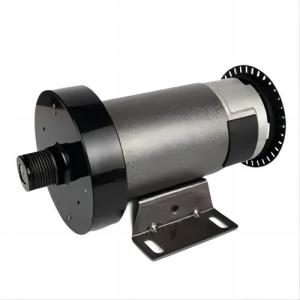

Add to Cart
Performance specifications
Outet dimensions
Overview
Essential details
Warranty:3years
Place of Origin:Guangdong, China
Brand Name:Go-Gold
Model Number:KG-GC103
Usage:the treadmill
Type:DC motor
Torque:customization
Construction:Series Wound
Commutation:Brush
Protect Feature:Totally Enclosed
Speed(RPM):4800RPM
Continuous Current(A):4-7.5A
Efficiency:IE 2
Product Name:KG-GC103
Port:SHENZHEN
Picture Example:
Brushed DC motors do not require a controller to switch current in the motor windings. Instead, it uses a mechanical commutation of the windings. A copper sleeve ( commutator ), resides on the axle of the rotor. As the motor turns, carbon brushes slide over the commutator, coming in contact with different segments of the commutator. The segments are attached to different rotor windings, therefore, a dynamic magnetic field is generated inside the motor when a voltage is applied across the brushes of the motor. The brushes and commutator are the parts of a brushed DC motor that are most prone to wear.
There are four types of brushed DC motors. The first type, is the Permanent Magnet Brush DC Motor. Second, the shunt-wound brushed DC motor. Third is the series-wound DC motor and fourth is the compound-wound brushed DC motor which is a combination of both the shunt and series wound brushed DC motors.
Permanent magnet brushed DC motors are the most common. These motors use permanent magnets to produce the stator field. They are generally used in applications needing fractional horsepower such as; Toys, Radio Control hobby applications, electric slot cars, appliances, etc. It is more cost effective to use permanent magnets than wound stators because they are cheaper to manufacture. The torque from a permanent magnet brushed DC motor is limited by its stator field, which gives it good low end ( low speed ) torque and a limited high end ( high speed ) torque. The permanent magnet brushed DC motor responds very quickly to changes in voltage. This is due to its constant stator field, thus giving it good speed control capabilities.
Shunt-wound brushed DC motors have the field coil in parallel ( shunt ) with the rotor. The current in the field coil and in the rotor are independent of one another, thus, the total current of the motor is equal to the sum of the shunt current ( or stator current ) and the rotor current. So, during normal operation, as the supplied voltage is increased the total current of the motor will increase causing the stator and rotor fields to increase. As total current increases motor speed will increase, thus motor torque will decrease. However, once you put a load on the motor the rotor current will increase causing the rotor field to increase. If the rotor current increases then the shunt current will decrease causing the stator field to decrease. This will cause the motor speed to decrease, thus the motor torque will increase.
